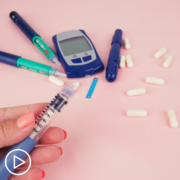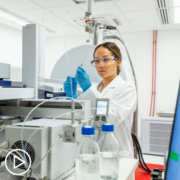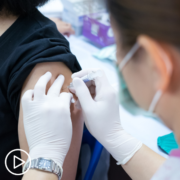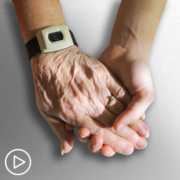Patient Profile Barry Marcus’ Multiple Myeloma Journey from Patient Empowerment Network on Vimeo.
Empowered patient, Barry Marcus, shares his multiple myeloma journey from searching for a diagnosis to how he is managing his disease today.
Transcript:
In May of 2014, I was signed up to do a charity bicycle ride in Portland for MS with my cousin, her husband, and her son, who has an MS. And about a week before the ride, I started feeling exhausted for no apparent reason, terrible fatigue. All I could really do was lay on the couch and this was completely anomalous for me. I didn’t really have any other symptoms. I didn’t have a cough or a fever, chills, sweating, anything.
After about three or four days I got an appointment with my primary care physician. I went in to see him and he did a few blood tests and the blood tests all came back normal. And he was baffled, he really didn’t understand what was going on. I think he did a test for zika virus, that was going around at the time. I asked him if I could have mononucleosis and he was basically pretty stumped, and really didn’t have any recommendations to go forward.
So, I went home, I got back on the couch, and when I still felt the same way after a week, I called up another appointment and found that he was on vacation. So I went to see one of his colleagues and she did some more blood tests. And at that visit I said to her, “When someone starts feeling like this just out of the blue your mind goes to very dark places”. I said, “Could I have something like leukemia?” and she said, “Oh no”. And that was that. Basically I felt cut adrift and the message was it’s too bad to be you. There’s another version of that that I won’t say.
And then after about two weeks, I started to feel better. The fatigue went away, I got back on my bike, and was able to go to work and be productive. So I just sort of shrugged my shoulders that this is just one of those strange things that doctors aren’t able to explain.
Then, probably about February or March of 2015, I started getting some pains in my neck. If I pulled over a sweatshirt and it caught on my head, I’d get a pretty serious pain in my neck. And as a couple of months pass, this pain got worse, especially when I rode my bike. And I thought well maybe it’s from all this bike riding and having my neck in a strange position.
So I didn’t really follow up at that time. About maybe in June, I went back to my primary care physician and told him about my neck and he sent me for an x-ray at that time. No other imaging, just an x-ray. And he told me that I had minor disc degeneration in my neck and that physical therapy would probably take care of it. So he sent me the physical therapy, and I did physical therapy for a couple of weeks and this pain in my neck did not get any better at all. And then one night I was walking my dog, and I got a, how can I describe it, it was a numb feeling down my left arm. It wasn’t really painful, felt a little electrical maybe, and I knew that wasn’t a good thing.
So I called up the advice nurse, she had an on-call physician call me back. He said you have to go in for an MRI and I’m going to set that up for you in the morning. In the morning, I went for the MRI and when I got out of the tube I went over to the technician who’d done the test and I said what do you see? And his face turned ashen, basically. And he said well I don’t interpret these you know, I just run the machine and you need to see your doctor. It turned out I had a solid tumor in my neck between C4 and C5, about the size of a walnut, and it was pressing on my spinal cord. And I got a call shortly thereafter from my primary care physician who said you need to go see a head and neck specialist and I’ve got that set up for you. And it went in to see him and he said yeah I’m sorry to tell you that you have what appears to me to be multiple myeloma.
So at that stage, I’m sure that I had had this for about a year. And in addition to the tumor in the neck, I had I guess they call them lytic lesions, I had what are essentially smaller tumors in my ribs and on my sternum. They did a PET scan and it’s pretty widespread. And they said the first thing that you need to do is to get radiation therapy to get rid of this tumor in your neck. The head and neck specialist that I saw said that it was very likely that we could get rid of the tumor and he said oh and you’ll be back on your bike in no time.
I felt like that was maybe true or maybe not true, that he was doing his best to encourage me that this wasn’t the end of the world, and of course, I was devastated. I went for radiation therapy for the tumor, I had ten treatments. To make a long story short, the radiation was very successful. I’m going to have to otherwise describe it as it melted the tumor away. It was gone and the next phase was going to be chemotherapy.
I was assigned to an oncologist through my health plan, and I don’t want to be culturally insensitive in talking about this, but his English was not his second… first language. And I had a very hard time understanding him, especially on phone calls where I couldn’t understand him at all. I was feeling pretty down at that point because my primary care physician hadn’t followed up with me, and now I have an oncologist that I’m having problems communicating with, and they provided me with what seemed to me like a cookie cutter – this is the plan that we put everybody through type of chemotherapy.
I wanted to find out much more about it, so I’m very fortunate to have a sister who’s an MD and at the time, before her retirement, she worked at Montefiore Hospital in New York. I called her and she said well I’m good friends with an oncologist here and I want you to talk to him, which I did and his name is Shalom Kalnicki at Montefiore. And he became what we started to call my New York team and I bounce things off of him. The first thing he said was you really do need to get a second opinion and I’m going to set you up at another health provider that I have a lot of confidence in, that I’ve known people there for years. He said I wouldn’t take the chemotherapy that they’re suggesting until you talk to them.
Well that was…I got an appointment for the second opinion, but it was about a month away. That was an agonizing month because I knew I had these lesions, that I had myeloma, and I wanted to jump on it and get immediate treatment, but I didn’t. I waited. I went in and the physician I saw at the second Health Plan, I really liked a lot and she spent a lot of time with me. She looked at some of the other tests that had been done, and basically said yeah your health plan is on the right track, I would go ahead and start it. So I did, but again I frankly felt that if I stayed with my health plan and they were going to kill me.That I was sort of a cog in the wheel, that they basically treated everybody the same way, whether that’s true or not, I don’t know, but that’s how I felt.
And as it happens, August of 2015 and I was turning 65 in September. And it turned out that turning 65 and becoming medicare-eligible, was what they call a qualifying event to change your health plans outside of Open Enrollment. I have to credit CalPERS for that because I went to see them about what my possibilities might be ‘cause I didn’t want to wait till January to get a new Health Plan through Open Enrollment. A woman there was extremely helpful and she told me this information, and so I did change in September I got onto a new health plan that I had been in many years ago that I really liked. What CalPERS had removed from their list of approved providers because of cost, but at that point, they were back. So, I got back in this plan that I’ve been in many years ago, got hooked up with a terrific hematologic oncologist September 1st, and started working with him.
I wound up getting an autologous stem-cell transplant in February of 2016, about 5 years ago, and it produced…I was in the hospital for two weeks. The other health plan that I had been in, if I had a stem-cell transplant through them, they were going to send me 90 miles away and it was an outpatient procedure. I would have had to stay in a rental apartment for 30 days. So, I felt really good about changing health plans. That’s a piece of advice I would give to people is to really do some research and find out in your area where the best providers are, who they are, and see if you can hook up with them.
So after the stem-cell transplant, I had what they called a very good partial response. I was in remission for a year-and-a-half, at which time I didn’t need to be on any maintenance medications and felt great. I got back on the bike doing, you know, up to 50-mile rides and it was good.
But after a year-and-a-half, that was 2017, I relapsed and I had to go back on a chemotherapy regimen that was oral drugs. It was a 3-drug regimen and it kept my myeloma numbers down pretty significantly. Then I would say about a year ago, that regimen stopped working, which is very common, that I came to learn, in myeloma patients that you can go through many many many different treatment regimens during the course of your illness.
So about a year ago, my oncologist switched me to a different regimen that required infusions. So now I’m on IV infusion 3 out of 4 weeks a month and they’re very, very effective on what I would call complete remission. These are Kyprolis, Darzalex, and Dexamethasone. The worst side effect is neuropathy, which is also I’ve learned very common in myeloma treatment. Most people get neuropathy. Mine’s not too bad and it’s mostly in my feet and doesn’t prevent me from riding or walking and doesn’t affect my balance, so I feel, again, pretty fortunate there.
We’re going to stay on that regimen until it too stops working which seems to be inevitable, but I’m very encouraged by lots of the research going on for new myeloma treatments. So I guess, most people know there’s no cure, but they call it manageable and that brings me to the present.
Read more patient stories here.
























